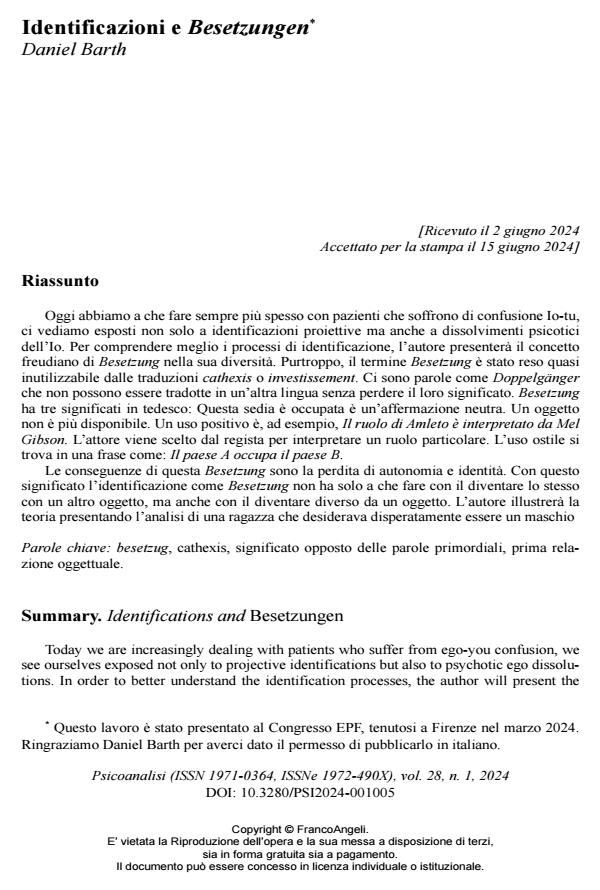Identificazioni e Besetzungen
Titolo Rivista PSICOANALISI
Autori/Curatori Daniel Barth
Anno di pubblicazione 2024 Fascicolo 2024/1
Lingua Italiano Numero pagine 13 P. 59-71 Dimensione file 185 KB
DOI 10.3280/PSI2024-001005
Il DOI è il codice a barre della proprietà intellettuale: per saperne di più
clicca qui
Qui sotto puoi vedere in anteprima la prima pagina di questo articolo.
Se questo articolo ti interessa, lo puoi acquistare (e scaricare in formato pdf) seguendo le facili indicazioni per acquistare il download credit. Acquista Download Credits per scaricare questo Articolo in formato PDF

FrancoAngeli è membro della Publishers International Linking Association, Inc (PILA)associazione indipendente e non profit per facilitare (attraverso i servizi tecnologici implementati da CrossRef.org) l’accesso degli studiosi ai contenuti digitali nelle pubblicazioni professionali e scientifiche
Oggi abbiamo a che fare sempre più spesso con pazienti che soffrono di confusione Io-tu, ci vediamo esposti non solo a identificazioni proiettive ma anche a dissolvimenti psicotici dell’Io. Per comprendere meglio i processi di identificazione, l’autore presenterà il concetto freudiano di Besetzung nella sua diversità. Purtroppo, il termine Besetzung è stato reso quasi inutilizzabile dalle traduzioni cathexis o investissement. Ci sono parole come Doppelgänger che non possono essere tradotte in un’altra lingua senza perdere il loro significato. Besetzung ha tre significati in tedesco: Questa sedia è occupata è un’affermazione neutra. Un oggetto non è più disponibile. Un uso positivo è, ad esem-pio, Il ruolo di Amleto è interpretato da Mel Gibson. L’attore viene scelto dal regista per interpretare un ruolo particolare. L’uso ostile si trova in una frase come: Il paese A occu-pa il paese B. Le conseguenze di questa Besetzung sono la perdita di autonomia e identità. Con questo significato l’identificazione come Besetzung non ha solo a che fare con il diventare lo stesso con un altro oggetto, ma anche con il diventare diverso da un oggetto. L’autore illustrerà la teoria presentando l’analisi di una ragazza che desiderava disperatamente essere un maschio
Parole chiave:besetzug, cathexis, significato opposto delle parole primordiali, prima relazione oggettuale.
Daniel Barth, Identificazioni e Besetzungen in "PSICOANALISI" 1/2024, pp 59-71, DOI: 10.3280/PSI2024-001005